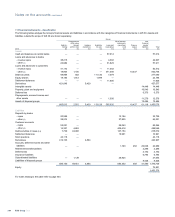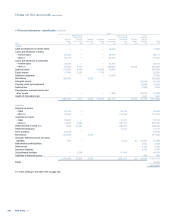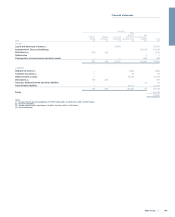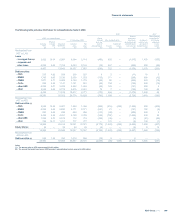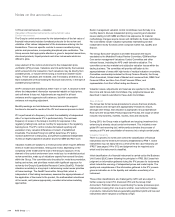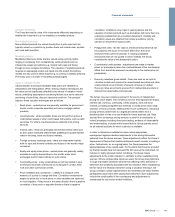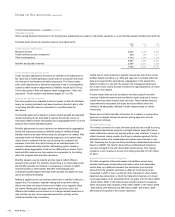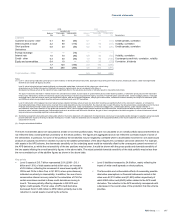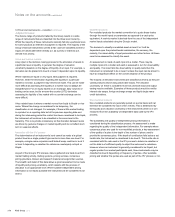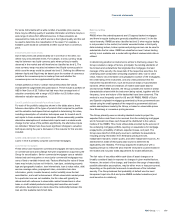RBS 2010 Annual Report Download - page 312
Download and view the complete annual report
Please find page 312 of the 2010 RBS annual report below. You can navigate through the pages in the report by either clicking on the pages listed below, or by using the keyword search tool below to find specific information within the annual report.12 Financial instruments - valuation
Valuation of financial instruments carried at fair value
Control environment
The Group's control environment for the determination of the fair value of
financial instruments includes formalised protocols for the review and
validation of fair values independent of the businesses entering into the
transactions. There are specific controls to ensure consistent pricing
policies and procedures, incorporating disciplined price verification. The
Group ensures that appropriate attention is given to bespoke transactions,
structured products, illiquid products and other instruments which are
difficult to price.
Akey element of the control environment is the independent price
verification (IPV) process. Valuations are first performed by the business
which entered into the transaction. Such valuations may be directly from
available prices, or may be derived using a model and variable model
inputs. These valuations are reviewed, and if necessary amended, by a
team independent of those trading the financial instruments, in the light of
available pricing evidence.
All IPV variances are classified as either ‘hard’ or ‘soft’. A variance is hard
where the independent information represents tradable or liquid prices,
and soft where it does not. Adjustments are required for all hard
variances and for aggressive soft variances, but with conservative
variances not requiring adjustment.
Monthly meetings are held between the business and the support
functions to discuss the results of the IPV and reserves process in detail.
IPV is performed at a frequency to match the availability of independent
data. For liquid instruments IPV is performed daily. The minimum
frequency of review in the Group is monthly for exposures in the
regulatory trading book, and six monthly for exposures in the regulatory
banking book. The IPV control includes formalised reporting and
escalation of any valuation differences in breach of established
thresholds. The Global Pricing Unit (GPU) determines IPV policy,
monitors adherence to that policy, and performs additional independent
reviews on highly subjective valuation issues for GBM and Non-Core.
Valuation models are subject to a review process which requires different
levels of model documentation, testing and review, depending on the
complexity of the model and the size of the Group's exposure. A key
element of the control environment over model use is a modelled product
review committee, made up of valuations experts from several functions
within the Group. This committee sets the policy for model documentation,
testing and review, and prioritises models with significant exposure for
review by the Group's Quantitative Research Centre (QuaRC). Potential
valuation uncertainty is a key input in determining model review priorities
at these meetings. The QuaRC team within Group Risk, which is
independent of the trading businesses, assesses the appropriateness of
the application of the model to the product, the mathematical robustness
of the model, and (where appropriate), considers alternative modelling
approaches.
Senior management valuation control committees meet formally on a
monthly basis to discuss independent pricing, reserving and valuation
issues relating to both GBM and Non-Core exposures. All material
methodology changes require review and ratification by these committees.
The committees include valuation specialists representing several
independent review functions which comprise market risk, QuaRC and
finance.
The Group Executive Valuation Committee discusses the issues
escalated by the Modelled Product Review Committee, GBM and Non-
Core senior management Valuations Control Committee and other
relevant issues, including the APS credit derivative valuation. The
committee covers key material and subjective valuation issues within the
trading business. The committee will provide ratification to the
appropriateness of areas with high levels of residual valuation uncertainty.
Committee membership includes the Group Finance Director, the Group
Chief Accountant, Global Head of Market and Insurance Risk, GBM Chief
Financial Officer and Non-Core Chief Financial Officer, and
representation from front office trading and finance.
Valuation issues, adjustments and reserves are reported to the GBM,
Non-Core and Group Audit Committees. Key judgmental issues are
described in reports submitted to these Audit Committees.
New products
The Group has formal review procedures to ensure that new products,
asset classes and risk types are appropriately reviewed to ensure,
amongst other things, that valuation is appropriate. Group Operational
Risk owns the Group New Product Approval Process, the scope of which
includes new business, markets, models, risks and structures.
During 2010, the Group made a significant and ongoing investment into
enhancing its already robust control environment. This included a new
global IPV and reserving tool, which partly automates the process of
carrying out IPV and consolidation of reserves into a single central portal.
Valuation hierarchy
There is a process to review and control the classification of financial
instruments into the three level hierarchy established by IFRS 7. Some
instruments may not easily fall into a level of the fair value hierarchy per
IFRS 7 (see pages 314 to 315) and judgment may be required as to
which level the instrument is classified.
Initial classification of a financial instrument is carried out by the Business
Unit Control (BUC) team following the principles in IFRS. BUC base their
judgment on information gathered during the IPV process for instruments
which include the sourcing of independent prices and model inputs. The
quality and completeness of the information gathered in the IPV process
gives an indication as to the liquidity and valuation uncertainty of an
instrument.
These initial classifications are challenged by GPU and are subject to
further review by local CFO, divisional CFO and the Group Chief
Accountant. Particular attention is paid during the review processes upon
instruments crossing from one level to another, new instrument classes
or products, instruments that are generating significant profit and loss and
instruments where valuation uncertainty is high.
RBS Group 2010310
Notes on the accounts continued


